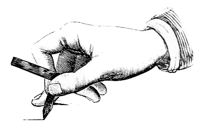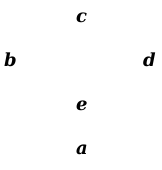Base, or Goal-ball 1834
from The Book of Sports by Robin Carver. Boston: Lilly, Wait, Colman, and Holden (1834)
Carver copied this entry nearly verbatim from the English Boys' Own Book rules of rounders from six years earlier. The most notable variance is the omission of the rule found in Clark according to which a ball hit behind the catcher is an out, the earliest hint of the concept of foul territory.
This game is known under a variety of names. It is sometimes called “round ball,” but I believe that “base,” or “goal ball” are the names generally adopted in our country. The players divide into two equal parties, and chance decides which shall have first innings. Four stones or stakes are placed from twelve to twenty yards asunder, as a, b, c, d, in the margin; another is put at e. One of the party, who is out, places himself at e. He tosses the ball gently toward a, on the right of which one of the in-party places himself, and strikes the ball, if possible, with his bat. If he miss three times, or if the ball, when struck, be caught by any of the players of the opposite side, who are scattered about the field, he is out, and another takes his place. If none of these accidents take place, on striking the ball he drops the bat, and runs toward b, or if he can, to c, d, or even to a again. If, however, the boy who stands at e, or any of the out-players who may happen to have the ball, strike him with it in his progress from a to b, b to c, c to d, or d to a, he is out. Supposing he can only get to b, one of his partners takes the bat, and strikes at the ball in turn. If the first player can only get to c, or d, the second runs to b, only, or c, as the case may be, and a third player begins; as they get home, that is, to a, they play at the ball by turns, until they all get out. Then, of course, the out-players take their places.

